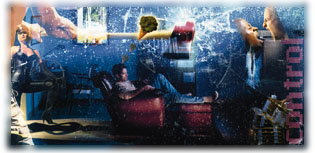Main Menu · Search ·Current Issue ·Contact ·Archives ·Centennial ·Letters to the Editor ·FAQs

Another Fine Mess Second-year M.B.A. student Pankaj Amin, who created the summary image above, decodes it as follows. The man seated in the center is tackling an ill-structured problem. Watching TV represents the information-gathering stage: "You really need to listen, have your eyes and ears open." Boxes stacked at the lower right suggests the need to process and categorize the data at hand. Two men shouting at the upper right indicate the need to understand the perspectives of others, "which can degenerate into arguments, because people often react on an emotional level to problems they don't understand." At the upper left, a painting of a beach with palm trees, captioned "everybody complains," has stripes running through it: "It's not a perfect picture." At top center, the axe shattering the pane of glass (actually an aquarium) demands that we "break through structures or mental constructs that constrain us." The word control along the right side, together with the leather-clad dominatrix on the left, remind us that we "don't necessarily have control over the situation...and that's not always a bad thing!" The shadow on the floor implies "issues you don't account for initially," and the ice-cream cones sprouting broccoli symbolize the ultimate outcome, which often "does not arrive in a commonplace format." |
"The problems people encounter most frequently are routine ones," says Gerald Zaltman, Wilson professor of business administration. "But the ones that tend to get us into trouble are the ill-structured or messy problems. They have no clear best answer, they aren't solvable using an existing formula, and in fact it's not even clear what the problem is." Yet such ill-structured problems often represent make-or-break moments in an executive's career. Perhaps, for example, there has been an insidious, gradual, but relentless ebbing of employee morale in the division one heads. Or a brand manager for a cereal manufacturer is struggling to find ways to connect breakfast foods with key transition points in children's life cycles. What to do?
Unfortunately, people often grapple with ill-structured problems in ways that cause even more difficulty. One habit is to approach them as if they were well-structured. "We do what we know how to do," says Zaltman. "That's a recipe for trouble, since our tried-and-true methods may be inappropriate." Another trap is to redefine the problem unconsciously, which Zaltman calls "telling a white lie, making it into something it isn't."
To explore such conundrums, Zaltman and his research staff have interviewed 55 senior executives as well as nine visual artists--painters, filmmakers, sculptors, a mask-maker, and the well-known documentary photographer Mary Ellen Mark--about how they approach ill-structured problems. "Visual artists approach messy problems daily," Zaltman explains. "They have something in mind, and have to figure out how to get it expressed. Managers are visual artists, too: a gifted executive has a strong, clear vision to realize--perhaps a vision of a strategy for a division or a product."
Researchers asked each subject to bring in several pictures that expressed their thoughts and feelings when engaged with ill-structured problems. The interviewers then used these pictures--often cut from magazines--as a focus for exploration. "It's a way to give participants the chance to say something very different from what the interviewer might be expecting," says Zaltman, who was trained as a sociologist. "It gets at a lot of tacit knowledge. We all know a lot that we don't know we know, but special prompts are needed to bring this out." Finally, the researchers scanned the most salient images into a computer and, under the direction of the subject, arranged those pictures into a collage, a summary image that expressed the interview's major themes.
In his Business School course, "The Customer Behavior Lab," Zaltman has continued this process via similar interviews with its 120 students, who share their summary images with each other in class. The aim is not to formulate a "how-to" approach for dealing with ill-structured problems, since there is no single method. Rather, Zaltman says, "It's a chance to learn from other visionaries. Maybe there's a tool here I can add to my box as an executive." The exercise can also enhance awareness of one's personal habits and characteristic approaches--as well as the useful ability simply to perceive ill-structured dilemmas as they arise.
"These situations don't walk into your office and announce they have to be solved in two weeks," Zaltman says. "Messy problems often creep up on you gradually. So alertness lets you respond more effectively; unless you are prepared and aware, you are going to get snuck up on frequently, with a lot of unpleasant outcomes."
~ Craig Lambert